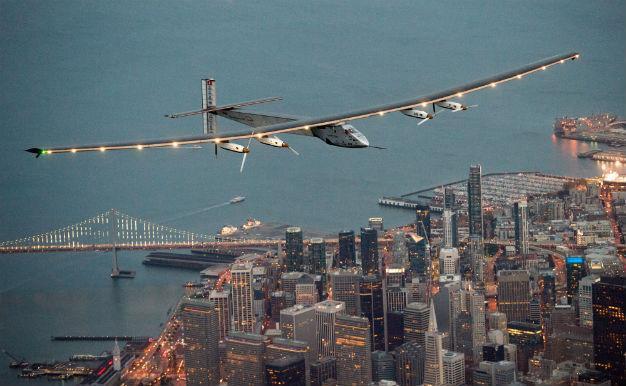Solar-powered plane lands in California after Pacific crossing
MOUNTAIN VIEW - Agence France-Presse

AP photo
Solar Impulse 2, an experimental plane flying around the world without consuming a drop of fuel, has landed in California, one leg closer to completing its trailblazing trip.
"The Pacific is done, my friend. I love it, but it's done," said clearly relieved Swiss adventurer Bertrand Piccard, who piloted the craft from Hawaii to California, just before landing late April 23.
"It's great to be in California, the land of pioneers," he said once on the ground, with Google co-founder and alternative energy enthusiast Sergey Brin on hand.
"Innovation and pioneering must continue. The clean tech revolution has to keep moving forward."
Piccard, a 58-year-old doctor by training, said that enduring the 62-hour stretch between Hawaii and the Silicon Valley town of Mountain View was one of the "most amazing" experiences of his life.
"I bet that in 10 years, electric airplanes will be transporting up to 50 people. This will happen," he added.
"This is not science fiction. It is real," Piccard said.
The arrival at Moffett Airfield southeast of San Francisco, marked the completion of the ninth of 13 legs in a journey that began last year in the United Arab Emirates.
Piccard, who has been alternating the long solo flights with teammate Andre Borschberg, will now hand over to his teammate who will pilot Solar Impulse across the United States and to New York.
The mission aims to promote the use of renewable energy, with an aircraft powered by 17,000 solar cells.
The plane's wingspan is wider than that of a jumbo jet but its weight is roughly the same as a car's.
Solar Impulse 2 was grounded in July last year when its batteries suffered problems halfway through its 21,700-mile (35,000-kilometer) circumnavigation.
The crew took several months to repair the damage from high tropical temperatures during the first Pacific stage, a 4,000-mile flight between Japan and Hawaii.
The aircraft was flown on that leg by Borschberg, whose 118-hour journey smashed the previous record of 76 hours and 45 minutes set by US adventurer Steve Fossett in 2006.
Born in Zurich, Borschberg is no stranger to adventure -- 15 years ago he narrowly escaped an avalanche, and then in 2013 he was involved in a helicopter crash that left him with minor injuries.
The 63-year-old took catnaps of only 20 minutes at a time to maintain control of the pioneering plane during his arduous flight from Japan, in what his team described as "difficult" conditions.
The Pacific crossing is the most dangerous due to a lack of landing sites in the event of an emergency.
Traveling at altitudes of more than 9,000 meters (29,500 feet), Borschberg at times had to use oxygen tanks to breathe and experienced huge swings in temperature throughout.
Alone throughout and utterly self-reliant in the unpressurized cockpit, he was equipped with a parachute and life raft in case he needed to ditch in the Pacific.
Piccard said on April 23 that he could not sleep more than 20 minutes at a time "because after 20 minutes you have to wake up and control everything and if everything goes well then you can go back to sleep."
The solar-powered plane, which stores energy in batteries for when the sun is not shining, will stop in New York before a transatlantic flight to Europe. From there the pilots plan to make their way back to the point of departure in Abu Dhabi.
